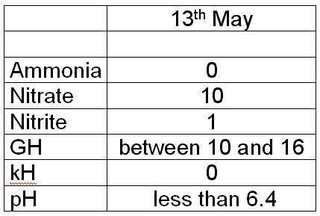tyl3r
New member
- Joined
- Jan 24, 2008
- Messages
- 57
- Reaction score
- 5
- Points
- 0
- Location
- North of England
- Country
- United Kingdom
Great news that your ammonia has reached zero. Your persistence will pay off.
To answer your unanswered question about water depth - there's no reason why you can't double the depth. It'd give you a more stable cycling (ie fluctuations not as violent) and reduce the %age flow (though, of course, not the actual rate) and in the short term immediately halve your nitrite reading which is higher than I would accept personally.
As for the amount to change, 20% is the generally accepted figure. However, the bacteria that you're trying to cultivate generally live on the surfaces so doing a higher %age when you've got such high nitrite (and nitrate) readings might be better. It's a balancing act and not everyone will agree on the exact percentages.
I think the reason your cycling is taking so long is possibly down to the low pH. Generally I, and most people, would advise against adding anything to the water to increase the pH. However, some natural items can be used safely to increase the pH to between, say, 7.0 and 7.5. If you pH was higher then this would allow the cycle to run faster. These same items might also increase the hardness of your water which seems a little soft at the moment.
Don't get too disheartened if this seems like you're getting bad feedback. You're doing the right thing... it just might be made a bit easier on you (and the axy) if the water volume was increased, the change %age increased slightly and pH increased.
To answer your unanswered question about water depth - there's no reason why you can't double the depth. It'd give you a more stable cycling (ie fluctuations not as violent) and reduce the %age flow (though, of course, not the actual rate) and in the short term immediately halve your nitrite reading which is higher than I would accept personally.
As for the amount to change, 20% is the generally accepted figure. However, the bacteria that you're trying to cultivate generally live on the surfaces so doing a higher %age when you've got such high nitrite (and nitrate) readings might be better. It's a balancing act and not everyone will agree on the exact percentages.
I think the reason your cycling is taking so long is possibly down to the low pH. Generally I, and most people, would advise against adding anything to the water to increase the pH. However, some natural items can be used safely to increase the pH to between, say, 7.0 and 7.5. If you pH was higher then this would allow the cycle to run faster. These same items might also increase the hardness of your water which seems a little soft at the moment.
Don't get too disheartened if this seems like you're getting bad feedback. You're doing the right thing... it just might be made a bit easier on you (and the axy) if the water volume was increased, the change %age increased slightly and pH increased.

